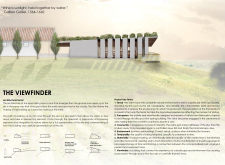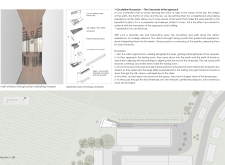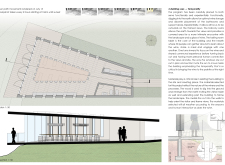5 key facts about this project
The wine tasting room is located in a beautiful vineyard landscape, designed to connect visitors with the natural world. This place embodies the idea of "architectural terroir," where the building rises from the ground, representing the process of wine growth. The design focuses on creating an engaging experience for visitors, allowing them to fully appreciate the elements of wine and its environment.
Design Concept
The main idea of the design is to highlight the relationship between the earth and sky. Visitors follow a carefully planned path that leads them to the tasting room, enhancing their anticipation for the wine tasting. This journey through the site prepares guests, bridging the gap between nature and the structured space dedicated to enjoying wine.
Spatial Organization
Inside the tasting room, the layout follows the concept of a "viewfinder," capturing key scenes of the vineyard and connecting the indoor and outdoor spaces. As visitors enter, they walk through a deep portal made from natural stone, which adds a strong visual focus and directs attention to the large glass walls that showcase the vineyard views. The combination of these elements creates a space that encourages exploration and enjoyment of the wines.
Materiality and Texture
The choice of materials is important to the overall feel and theme of the design. The natural stone at the entrance gives a tactile link to the land, while oak wood inside adds warmth and welcomes visitors. These materials not only shape the building’s appearance but also resonate with the processes involved in both architecture and winemaking, emphasizing a connection to the ground.
Light and Environment
Natural light plays a key role in the experience, with windows placed to maximize brightness during the day. An intimate cantilevered balcony extends from the building, allowing guests to connect with the vineyard views directly. This thoughtful approach to light and space enhances the visitors’ relationship with the wine and deepens their understanding of where it comes from.
Additionally, the layout includes communal areas that encourage social interaction among guests. By balancing private and shared spaces, the design fosters both individual reflection and group engagement. These thoughtful details help create a richer experience, highlighting the connection between visitors and the wine they are tasting.






















































